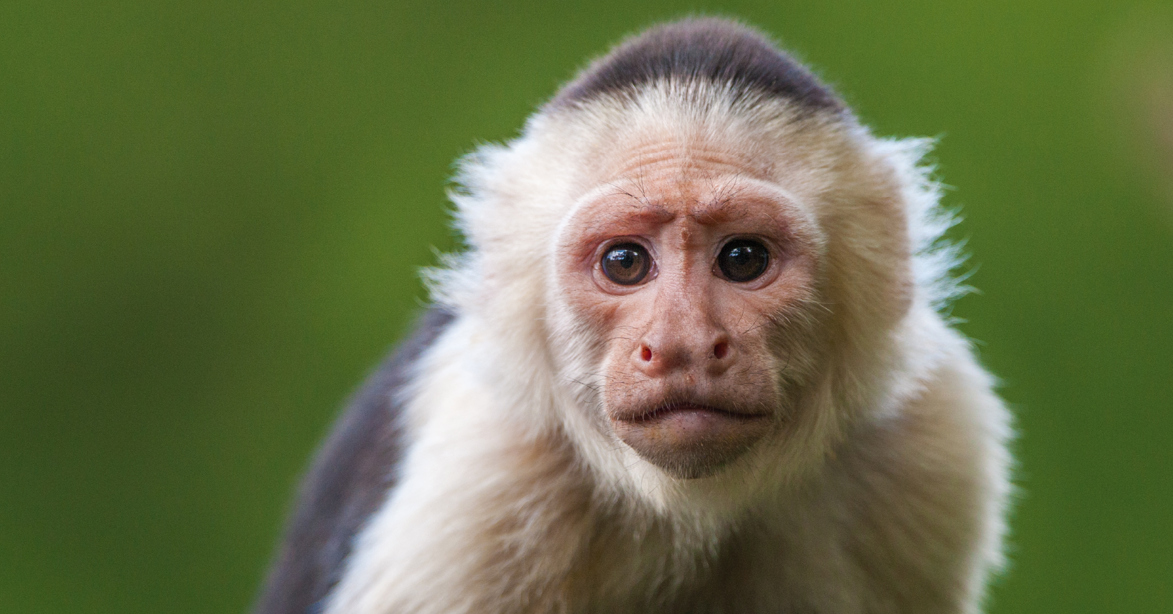Colombian white-faced capuchin
Cebus capucinus
Habitat
Rainforests and mangroves
Food
Fruit, seeds and insects
Weight
♂ ± 3 kg | ♀ ± 2 kg
Age
30 to 45 years
IUCN Status
Kwetsbaar
Appearance
You can recognise Colombian white-faced capuchins by the white fur on their shoulders, chest and face. The rest of the body is black and relatively slender build. On top of their round heads they have a black cap. These animals have very expressive faces.
Habitat
In the wild, Colombian white-faced capuchins live in Central- and South-America. There they inhabit the tropical forests of Panama, Costa Rica, Ecuador and Nicaragua. Capuchin monkeys mostly spend time in the canopy of the forest, about 15-20 meters high.
Lifestyle
Colombian white-faced capuchins live in groups of 10-20 animals on average. Multiple males and females live in one large group. Often the females are in majority and one of the males is most dominant. This alpha male can get to the best resources. The other males spend more time on the periphery of the group.
Behaviour
Capuchins use many different facial expressions to communicate with each other. Besides that, they have a rich vocal repertoire of sounds and calls. They are one of the most intelligent monkey species in South-America. They will easily come up with fast ways to access difficult to reach food. An example is the way they use their environment to open nuts, e.g. by using tree trunks to hit the nuts against to open it. Sometimes they will even use a stone, like a nutcracker. And they use small twigs to peel out larvae and caterpillars from small holes.

Reproduction
Female Colombian white-faced capuchins get pregnant once every two years. After birth, females other than the mother are allowed to carry offspring as well. How convenient! This will unburden the mother so she can get some rest. The infants are weaned after one year. At 3,5-4 years of age, the females become fertile themselves. Males will leave the group and immigrate into another capuchin group.
Situation in the wild
Colombian white-faced capuchin populations in the wild are getting more threatened every year. Causes are deforestation, habitat degradation and illegal hunting. Also, these animals sometimes end up as pets as well, in the illegal wild life trade. Fortunately they live in large areas (e.g. protected areas) and are real opportunists; having a diverse diet, they can survive in many different habitats.

At Apenheul
One of our Colombian white-faced capuchins at Apenheul is easily recognisable: Oemi. She has only one hand, as a result of an accident. Luckily she is coping well, and the caretakers take her into account when providing food, e.g. providing food somewhat lower to the ground or cracking walnuts for her.
Population management programme
Apenheul is part of the European population management programme (EEP) for the Colombian white-faced capuchin. Together with other zoos, we actively strive to maintain genetically healthy and demographically stable populations for this species in zoos that serves as a reserve population.
Fun facts
- There are many species of capuchins. At Apenheul we have two species: white-faced capuchins and yellow-breasted capuchins.
- Capuchins have a clever way of repelling insects. They will anoint themselves and each other with strongly scented leaves, which keeps away the insects. At Apenheul we may have less insects compared to the wild, but we provide the capuchins with pieces of union or garlic to maintain their anointing ritual.
- Capuchin monkeys can move each of their fingers separately. This means they can pick up items between their thumb and index finger. There are only a few primates that can do this!
Want to see the White-faced capuchins at Apenheul?
Get your tickets now and spot all the primate species!

Welcome to Apenheul
Open from:
10.00 hour